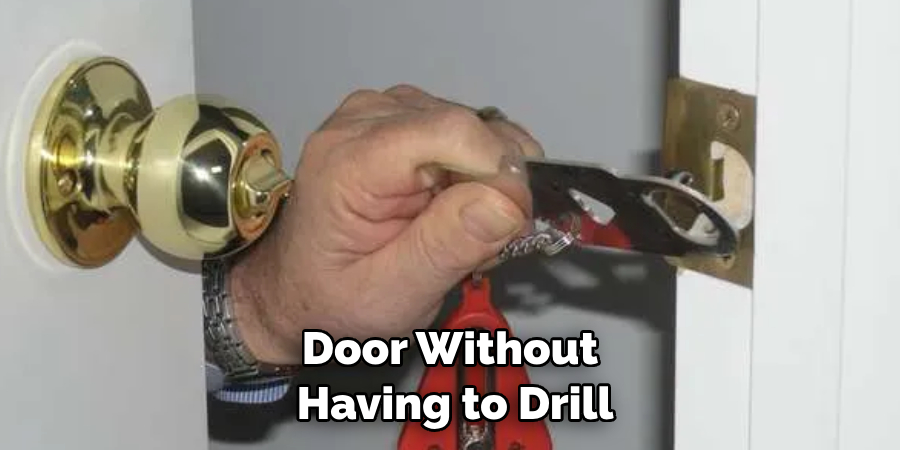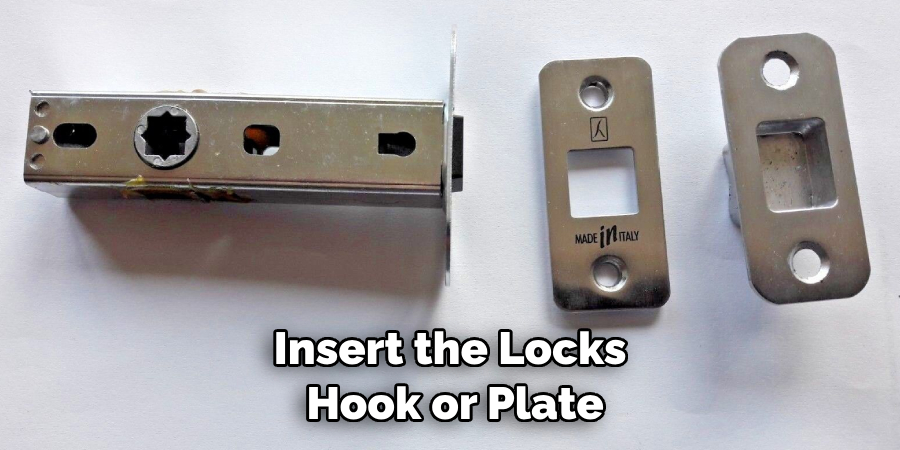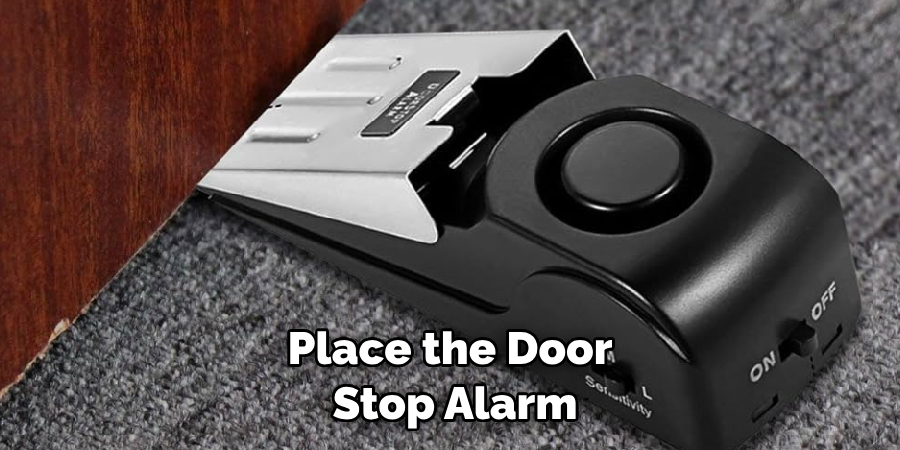Securing a door without drilling may seem like a daunting task, but it’s a valuable skill to have, especially when you want to add an extra layer of security to your living space without causing damage to the door or frame. Whether you’re a renter looking for non-destructive ways to fortify your apartment or simply prefer not to drill holes in your doors, this guide is here to help.

In this comprehensive article, we’ll explore how to put a lock on a door without drilling. From portable door locks to adhesive options and innovative locking devices, we’ll walk you through various techniques that will enable you to safeguard your privacy and belongings without compromising your door’s integrity. Join us on this journey as we discover effective, non-invasive ways to enhance security and peace of mind in your living space.
The Importance of Adding a Lock to a Door for Security and Privacy
Adding a lock to your door can be an important part of protecting your home and keeping yourself safe. Not only do locks prevent intruders from entering, but they also offer you privacy. With a lock on your door, you have control over who enters your space and when.

Fortunately, there are plenty of ways to add a lock to your door without having to drill into the frame. In this article, we will discuss how to securely add a lock without drilling, as well as some tips for ensuring it stays secure and effective.
The Benefits of Installing a Lock on Your Door
Installing a lock on your door provides several benefits. First, it ensures that your space remains private; only those with access to the key or code can enter. Second, locks provide an extra layer of security against intruders, making it more difficult for someone to break in. Third, some locks are equipped with alarm mechanisms that alert you to potential intrusions. Finally, installing a lock on your door may also increase the value of your home should you decide to sell it.
10 Steps How to Put a Lock on a Door without Drilling
Step 1: Choose the Right Locking Method
Begin by selecting the most suitable locking method that aligns with your security requirements. There are several non-drilling options available, each with its unique advantages:
- Portable Door Locks: These compact devices are designed to easily attach to the door’s existing latch or strike plate without requiring any tools. They offer a quick and effective way to add security to your door.
- Adhesive Locks: Adhesive-backed locks can be affixed to both the door and frame without the need for drilling. They are commonly used for childproofing purposes but can also serve as temporary security measures.
- Travel Door Locks: Ideal for travelers, these small but effective locks hook onto the strike plate or latch, providing an additional layer of security for temporary stays.
Step 2: Measure and Prepare

Before applying any lock, it’s essential to measure the thickness of your door to ensure compatibility with your chosen locking method. Additionally, prepare the door and frame by cleaning them thoroughly to ensure the adhesive will adhere securely.
Step 3: Install a Portable Door Lock
If you’ve opted for a portable door lock, follow these steps:
- Insert the lock’s metal hook or rod into the strike plate hole (the hole where the door’s latch bolt goes).
- Close the door and slide the lock into place, ensuring it snugly fits against the door frame.
- Follow the manufacturer’s instructions to secure the lock, which may involve locking or fastening mechanisms unique to the specific lock you’re using.
Step 4: Apply an Adhesive Lock
For adhesive locks, the installation process typically involves:
- Carefully positioning the lock on both the door and frame in a way that offers the most security.
- Peeling off the adhesive backing and pressing the lock firmly in place, ensuring it adheres securely to both surfaces.
- Allowing the adhesive to set according to the manufacturer’s instructions, ensuring a strong and reliable bond.
Step 5: Attach a Travel Door Lock
If you’ve chosen a travel door lock, follow these steps:

- Insert the lock’s hook or plate into the door’s latch or strike plate.
- Slide the lock into place, ensuring it rests securely against the door frame.
- Engage the lock following the manufacturer’s provided guidelines, which may include unique locking mechanisms specific to the lock in use.
Step 6: Consider a Door Barricade
An alternative to traditional locks, a door barricade can provide substantial security without the need for drilling. These devices brace the door from the inside, making it extremely challenging to force the door open. Simply place the barricade in position according to the manufacturer’s instructions, ensuring it is secure and snug.
Step 7: Install a Door Jammer
A door jammer is a portable device designed to prevent the door from opening by bracing against the floor. To use it effectively:
- Adjust the length of the jammer to match your door’s height.
- Slide the jammer under the door and tighten it securely, ensuring it provides strong resistance when pressure is applied.
Step 8: Explore Biometric or Smart Locks
For those seeking advanced security features, biometric or smart locks can be excellent options. These locks do not require drilling and offer convenient ways to secure your door:
- Biometric Locks: These locks use fingerprint recognition technology, allowing only authorized individuals with registered fingerprints to unlock the door.
- Smart Locks: Smart locks can be controlled via a smartphone app, keypad entry, or other electronic means. Some models do not require any physical alterations to the door or frame.
Step 9: Use a Door Stop Alarm
A door stop alarm is a versatile security device that acts as both a doorstop and an alarm. It emits a loud sound if someone attempts to force the door open. To use it:

- Place the door stop alarm in front of the door, ensuring it is positioned securely.
- Activate the alarm according to the manufacturer’s instructions.
Step 10: Invest in Reinforcement Hardware
To add an extra layer of security, consider reinforcement hardware such as security bars, strike plate locks, or hinge locks. While these may involve minimal drilling or modification, they can significantly enhance your door’s resistance to forced entry without causing extensive damage.
Things to Consider When Putting a Lock on a Door without Drilling
Before you decide to put a lock on a door without drilling, there are several things to consider. First and foremost, it is important to make sure that the door you are planning to lock has enough room for the hardware you plan on using. This means measuring the width and thickness of your door before purchasing any locks or other hardware.
Another important thing to consider is the type of lock you plan on using. Depending on the type of door and security needs, there are various types of locks available that don’t require drilling. Some of these include door knob locks, lever handle locks, and push button locks.
It’s also important to consider if any special tools or additional hardware are required for installation. Many no-drill door locks come with all the necessary mounting and installation hardware, but some may require a special drill bit or other tools.
Safety Precautions for Putting a Lock on a Door without Drilling
It’s easy to put a lock on a door without drilling. However, you should take the proper safety precautions before attempting this task. Here are some tips to ensure your project is completed safely:
- Read all instructions carefully before beginning the job. Make sure to understand each step and have all of the needed tools ready prior to starting.
- Wear safety glasses, gloves and a dust mask when working. This will help protect you from splinters, dust and debris.
- Use clamps to hold the lock securely in place while you work. This will help ensure that the lock is properly aligned with the door and won’t move during installation.
- Make sure all screws are tightened properly before testing the lock. Loose screws can cause the door to stick or jam when it’s opened or closed.
- Double check that all connections are tight and secure once the lock has been installed. This will help prevent any further problems down the line when using your new lock.
Conclusion
In conclusion, putting a lock on a door without drilling is an achievable task. From using adhesive locks to cutting-edge technology locks, there are multiple options available so you can have the right fit for any door. Be sure to select the right kind of lock for your door type before you go through the installation process.
If you’re really unsure, calling a professional is always an easy, safe option that ensures that your lock will last long. No matter what path you choose, having the extra layer of security from a lock will make all the difference in terms of protecting your home and possessions from malicious actors. So don’t wait any longer—take measures today to ensure your home is secure by learning how to put a lock on a door without drilling!
About
Safety Fic is a distinguished figure in the world of Diy design, with a decade of expertise creating innovative and sustainable Diy solutions. His professional focus lies in merging traditional craftsmanship with modern manufacturing techniques, fostering designs that are both practical and environmentally conscious. As the author of diy, Safety Fic delves into the art and science of Safety Fic-making, inspiring artisans and industry professionals alike.
Education RMIT University
(Melbourne, Australia) Associate Degree in Design (Safety Fic) Focus on sustainable design, industry-driven projects, and practical craftsmanship. Gained hands-on experience with traditional and digital manufacturing tools, such as CAD and CNC software.
Nottingham Trent University
(United Kingdom) Bachelor’s in diyfastly.com and Product Design (Honors) Specialized in product design with a focus on blending creativity with production techniques. Participated in industry projects, working with companies like John Lewis and Vitsoe to gain real-world insights.
Publications and Impact
In diy, Safety Fic his insights on indoor design processes, materials, and strategies for efficient production. His writing bridges the gap between artisan knowledge and modern industry needs, making it a must-read for both budding designers and seasoned professionals.
